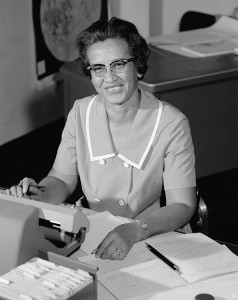Women’s History Month: Katherine Johnson
Wednesday, March 20th, 2019March 20, 2019
In honor of Women’s History Month in the United States, World Book looks at the American mathematician Katherine Goble Johnson. For many years, Johnson worked for the National Aeronautics and Space Administration (NASA), where she performed notable spaceflight calculations. She calculated the trajectory (path) for Apollo 11, which made the first landing on the moon. As a black woman in a racially segregated United States, Johnson broke many racial and gender barriers to excel as a mathematician.
Johnson was born on Aug. 26, 1918, in White Sulphur Springs, West Virginia. She was fascinated by numbers from a young age, and she excelled in her studies. In 1937, she received a bachelor’s degree in mathematics and French from West Virginia State College. She then took a job teaching mathematics at a grade school in Marion, West Virginia. In 1939, Johnson was selected to join West Virginia University’s graduate mathematics program. She enrolled, becoming the first black woman to attend the university.
In 1953, Johnson learned that the National Advisory Committee for Aeronautics (NACA) Langley Research Laboratory in Hampton, Virginia, was hiring women mathematicians. That summer, she was assigned to Langley’s West Area Computing unit, a group of black women mathematicians headed by Dorothy Vaughan. Johnson was soon reassigned to the Flight Research Division, where she analyzed data from flight tests. In 1958, NACA transitioned into NASA.
At NASA, Johnson and other Flight Research Division members were directly involved in the budding spaceflight program. In 1961, Johnson performed trajectory analysis for the Freedom 7 mission, investigating the route that was planned for the first U.S. human spaceflight. She also calculated the trajectory for astronaut John Glenn in his pioneering orbital flight around Earth in 1962. NASA’s new electronic computers had performed these calculations, but Glenn requested that Johnson personally check and approve them before the launch.
Johnson also calculated the exit and entry trajectories for the Apollo 11 mission, which landed the first two people on the moon in 1969. She authored or coauthored many research reports throughout her career. Johnson continued to make important contributions to NASA’s spaceflight program until her retirement in 1986. She has received multiple honors and awards. In 2015, President Barack Obama awarded her the Presidential Medal of Freedom. NASA’s Katherine G. Johnson Computational Research Facility—a data center at the Langley campus—was named in her honor in 2016. In 2019, NASA renamed its Independent Verification and Validation (IV&V) Facility the Katherine Johnson IV&V Facility.
American author Margot Lee Shetterly’s book Hidden Figures: The American Dream and the Untold Story of the Black Women Mathematicians Who Helped Win the Space Race (2016) chronicles Johnson’s life and career, along with those of other members of the West Area Computing unit. American actress Taraji P. Henson depicted Johnson in the 2016 film Hidden Figures, based on Shetterly’s book.



